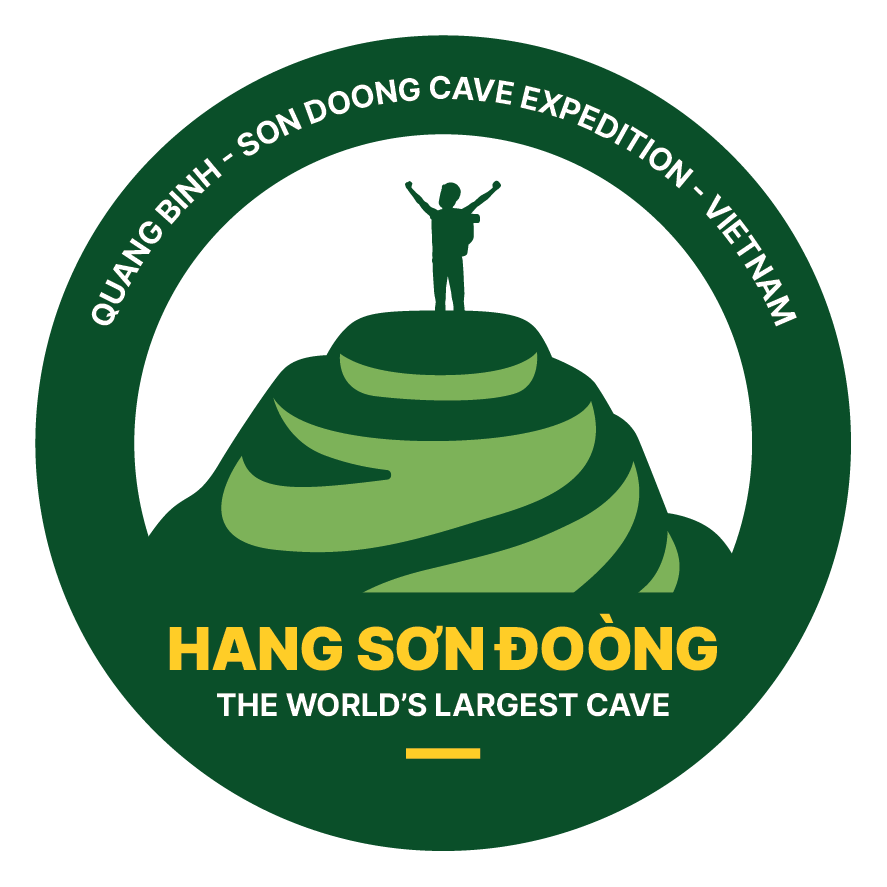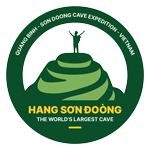About the diving expedition in Son Doong Cave to explore and learn about the connection between Son Doong Cave – the world’s largest cave and Hang Thung, a huge cave that found in 1994.
This is a 600-meter cave diving expedition in the underground river inside Son Doong Cave, which never been done or researched before, which means that the obstacles in the expedition are difficult to identify. There is no accurate information or the confirmation of the connection between Son Doong Cave and Hang Thung Cave until the diving expedition is completed with the final result. However, with all of the experiences the cave diving team had before; together with the professional porter team to help carry specialized equipment into the cave; the possibility of proving the connection between these caves, with positive results, is quite high. There will surely be many interesting things under the water.
1. INFORMATION ABOUT SON DOONG CAVE
SON DOONG CAVE
In 1994, members of The British Vietnam Caving Expedition Teamexplored Hang En and Hang Thung. A large river passes through Hang En, disappears underground and reappears in Hang Thung. In between was a gap of several kilometres. Hang En and Hang Thung are both large river caves, so the team expected there to be a significant cave in between. Every expedition they asked the local jungle men if they knew any entrances in the area which might lead to the cave, but no-one did.
In 2005 they met up with Mr Ho Khanh who knew a number of caves in the area. He had a vague memory of a cave he had seen about 20 years ago when foraging in the jungle. In 2007 he attempted to take the team there, but could not locate the cave. In 2008 he went back by himself to the jungle, and searched until he found the entrance again.
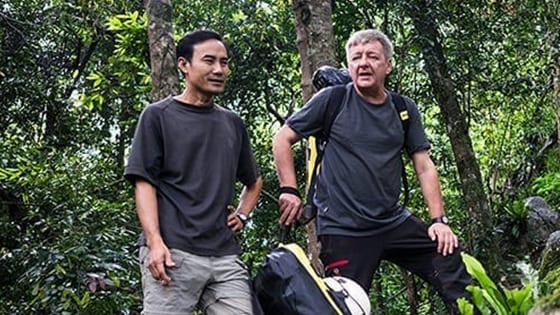
In 2009 a team of British cavers went to the area with Mr Khanh to explore a number of entrances. The first one they saw turned out to be Son Doong. Not only was it a significant cave, but probably the most significant cave in Vietnam. After surveying (measuring and mapping the cave), they discovered its full dimensions. After further research they determined Son Doong to be the largest cave passage in the world. Other spectacular features make Son Doong an amazing place; underground rivers, huge formations, dolines or skylights, ancient fossils, unique species of fish and insects, plants and trees inside the cave. Exploration and surveying of the cave was completed in 2010, and National Geographic Magazine and Film Channel visited the cave. They produced a documentary and magazine article in 2011. This drew the attention of travellers to Vietnam, who started to visit Quang Binh and Phong Nha. Many documentary films have since been made from around the world.
Adventure tours began in 2013, and continue with a maximum of 1000 per year.
AMAZING FACTS
Son Doong Cave has the largest cave passage in the world, and was only explored in 2009.Two large rivers, Khe Ry and Rao Thuong, join together to form Son Doong Cave. The cave follows a large fault line 100m wide, which contributes to the huge size of the passages. The Phong Nha Ke Bang limestone is around 400 million years old, but Hang Son Doong is less than 3 million years old.
The cave has two skylights, which allow daylight into the cave. This enables the unusual formations like Phytokarst to develop, and also plants and trees to grow inside the cave. Spectacular sunbeams are often seen at the first doline. Mist and clouds usually form in the large cave passages and rise up to the dolines. An incredible place for photography, the huge size of the passage, and the light from the dolines enables everyone to record some memories. The Son Doong Expedition employs 100 local people as porters, chefs and safety assistants, raising the standard of living of many families in Phong Nha.
- Enough space for an entire New York City block complete with 40-story skyscrapers
An entire block of skyscrapers with that height? Can you imagine that? Son Doong Cave is a truly phenomenal place. At almost 9km long with sections reaching up to 200m tall and 160m wide, Son Doong amazes everyone with its extraordinary size and beauty. With a total measured volume of 38.5 million cubic metres, this comfortably surpasses Deer Cave in Malaysia, which was considered to be the previous record holder. Stalagmites up to 80m high have also been surveyed, the tallest ever encountered.
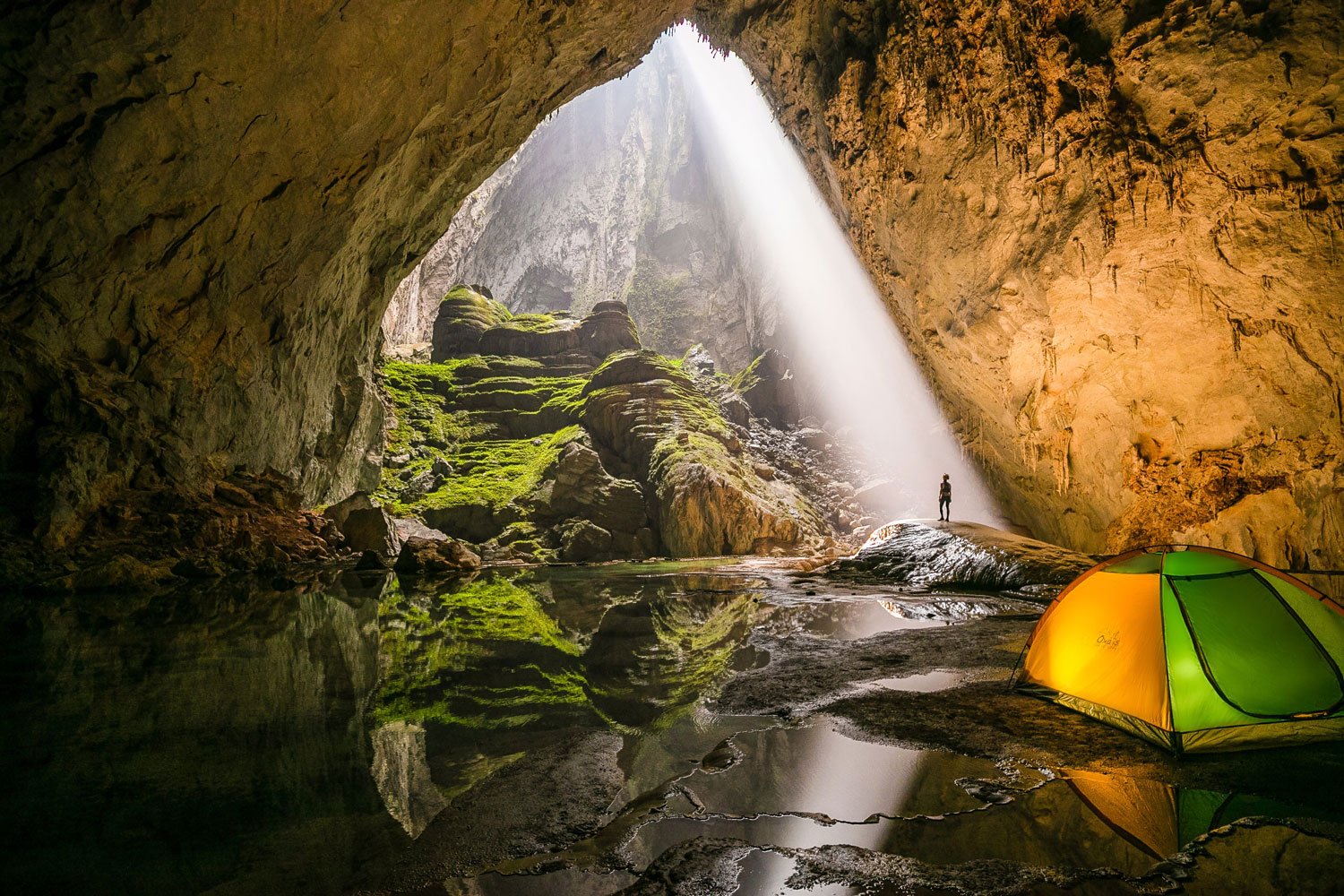
- Lush tropical jungle growing inside the cave
This cave will continue to amaze you. The ceiling collapsed hundreds of thousands of years ago forming gigantic windows which allow sunlight to penetrate into the darkness. This explains the lush tropical jungle, tall tropical trees, palms and even ferns. Where the ceiling collapsed, forming what we call dolines you may be able to witness the spectacular natural sunbeams. These shine into the cave at particular times of the year, and if you are lucky, you may be there to see it. These scenes are so surreal that no words or photographs are enough; you need to see to believe it!
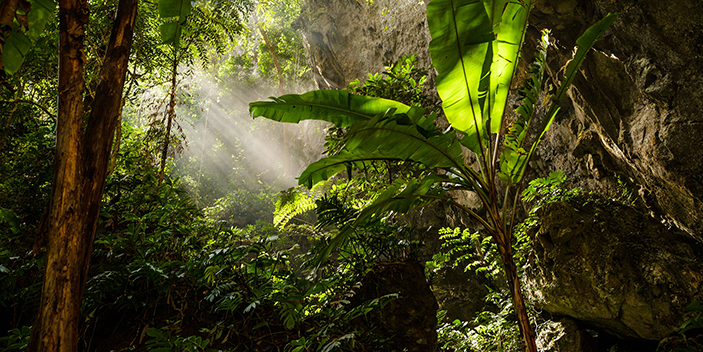
- Underground River and the Great Wall of Vietnam
Son Doong has a large underground river, and two river crossings. The final achievement whilst exploring Son Doong Cave is to climb the 90-meter-high calcite wall named ‘The Great Wall of Vietnam’. With safety harnesses, ropes and with the support of a safety advisor; you will conquer this massive wall and should be proud of it forever.
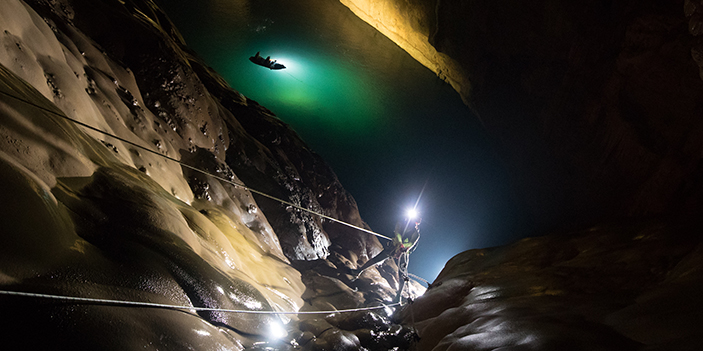
- The cave is so huge that it even has its own climate.
Son Doong Cave should be considered one of the world’s most unique caves. The huge size of the passage allows clouds to build up from the underground river. These rise up through the giant passages, offering vistors an extraordinary subterranean experience.
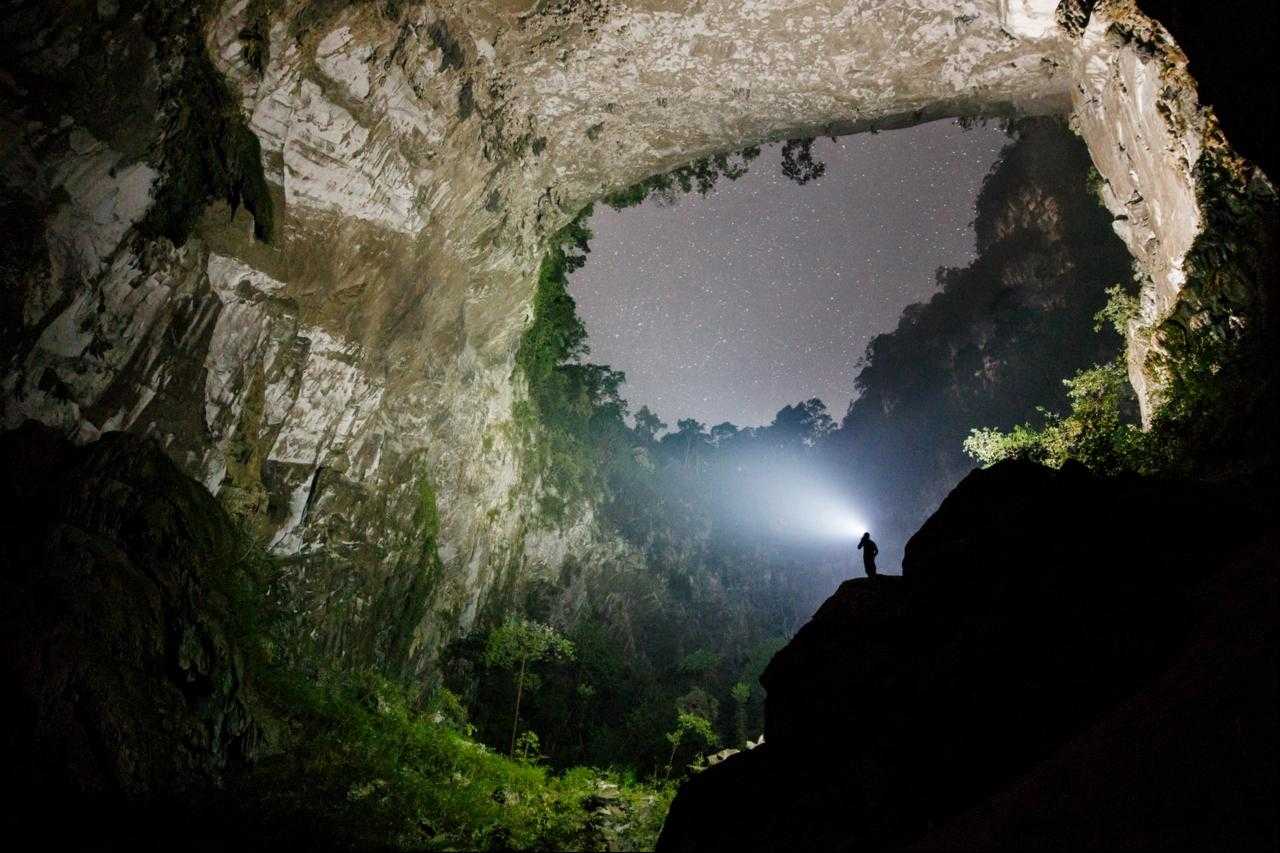
2. INFORMATION ABOUT HANG THUNG CAVE
LOCATION
The easiest way of approaching Hang Thung is by taking the new Ho Chi Minh Trail to the Tra Ang Bridge and turn left on the main Ho Chi Minh Trail towards Quang Ninh district. After 1km, a small path on the right leads off into the jungle. This crosses the Nuoc Nut resurgence water and before long a path climbs steeply up to a col and slowly descends to the collapsed doline which at its top end Hang Thung is located. It takes around 3-4 hours to walk to Hang Thung which is the main continuation of the Phong Nha river system.
ABOUT HANG THUNG CAVE
At the deep pool at the head of the collapsed doline 50m above and to the right two draughting entrances unite after 30m in a downwards sloping overflow passage. This soon enlarges dramatically in a massive 60m wide chamber with several static lakes. Cross one by a 30m swim to a 9m climb up. Above a smaller passage floored by fine gours is followed to where daylight can be seen. A short swim is needed to cross a big gour to the continuing rift passage. This passes below a 25m shaft (daylight) a short slope down to a 16m pitch with a rebelay at 4m. This fine pitch lands in a deep lake with the sound of a river in the distance.
A 70m swim soon reaches the main river, flowing over rapids in a clean washed passage over 30m high. Over the next 500m, gour pools are crossed by swimming, interspersed with rapids. A massive collapse is reached which is easiest to cross on the left hand side. Several short climbs are required to cross from boulder to boulder often over 30m long. A short section under two huge blocks leads into a huge area where the right hand wall is not seen. Traversing up over a sloping slab leads to a 3m diameter stal boss with a dribble from the ceiling 20m above. The collapse eventually leads back to the river and several more pools. A second shorter collapse is crossed above and a third is passed by swimming below a boulder. A section of elliptical passage sloping down from the right follows, with easy going on a clean washed floor to the right of the river. A dribbly inlet enters down a flowstone slope on the right.
Another big collapse follows, with the sound of roaring water ahead. Up a slope to the right here leads to brilliant gours and stals and a devious route to a balcony 30m above the river in a passage 1m wide. The best route is to climb about 3m above the water and squeeze through boulders back down to the river. A short arched duck follows into fast flowing canal.
50m forward the stream roars down a canyon about 1m wide. Progress is made by pulling along the walls until a very turbulent section is passed by a precarious traverse above the water. A fall here would be very serious. Around a bend the entire river falls from a 2m high cascade into a spray filled chamber. Fortunately a rift short cuts this section with an upwards 10m climb to a spacious lake chamber, the water falling away on the right hand side. A further swim leads to a series of rapids and a point where the passage is split by a high rock island, the river flowing to either side. To the right, a swim against the current leads to where it is possible to climb up onto the ‘island’. This allows a traverse on one wall with the rapids below, to another big lake chamber. Crossing this more rapids leads to a large stal portcullis with a passage above. This is about 1750m into the cave.
Continuing on an area of rapids is then passed to a long swim of about 300m. This narrows, and blocks in the water give a fighting chance against the considerable current. The river flows down a ramp from the left and the only way around this is to be flattened against the opposite wall for 10m until a niche allows a climb up above the water. A chamber with one wall formed from a detached flake over 30m long and high leads back down to a quieter canal area. The passage is more rift shaped with darker walls in this region of the cave.
The canal speeds up once again; progress is by following one wall until a further collapse provides a rest. A squeeze through blocks allows this to be surmounted and a big boulder pile followed down slope. This leads to an elbow bend to the left, with a 10m climb up the side of a big perched block. The river is seen again on the left, flowing down a series of noisy rapids. Traversing to the right on blocks leads to more rapids in the water and yet another lake. Gloomy swimming in a very wide dark canal ensues for 200m around several wide bends, with the route not obvious due to the size of the passage. Finally it is possible to land on a rock floor sloping up for 30m into a lovely polished rock overflow. The river comes from below the blocks in a large passage off to the right. This is around 2850m into the cave.
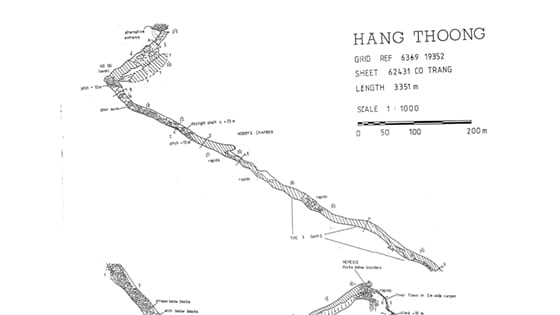
The passage to the right sumps after a further 70m of swimming. A 3m free dive enters a small airbell and continuing sump. Entering the overflow, a fine canyon ascends at 30 degrees, then flattens out and is floored by deep, clear pools. After 140m, this intersects a much larger gallery sloping from left to right, with a small stream in the floor. Downstream to the right, the passage dips into a deep lake almost immediately, a 40m swim to the far side revealing no above water continuation. To the left, the passage gradient flattens and a big slope of gours can be followed to the left, the passage being about 60m wide here. A small inlet enters down flowstone on the left, bats are seen entering here, but it quickly becomes too tight for humans. A rift beyond the passage slopes downwards once again, a deep gour necessitating a short swim. A fine staircase of gours is descended to the edge of a lake. This is crossed after 35m to the inevitable sumped continuation. The total length of Hang Thung is 3,351m and with over 6k to the known sink much more cave passage awaits discovery.
Hang Thung is a truly remarkable cave being one of the most sporting and challenging caves we have ever discovered in Vietnam. Superb situations and fabulous decorated huge cave passage make this cave to many of the people who were fortunate to be on the discovery the best cave they have ever been involved in exploring.
3. EXPLORE THE MYSTERIOUS INSIDE THE UNDERGROUND RIVER
Cave diving is a unique type of expedition; underground rivers have different lengths, depths, currents and water transparency; this requires the cave divers to be extremely experienced, proficient in the use of specialized and generic cave diving equipment, since they’re totally different from the equipment used in the ocean or open river diving. The underground river has many caves that are completely submerged in the water; this requires the diving expert to handle emergency situations well as they would not be able to emerge from the water for a long duration.
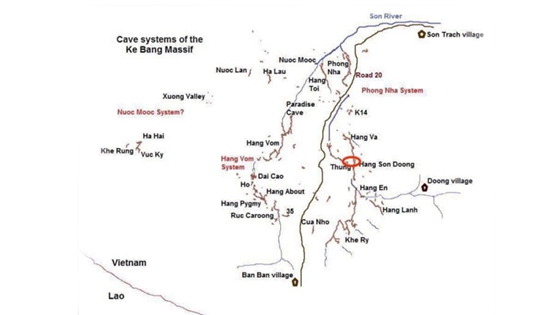
For over 30 years, The British Vietnam Caving Expedition Team has been conducting multiple cave explorations, surveys and researches to study the numerous cave systems present in the Quang Binh Province of Vietnam. Inviting the best cave diving experts in the world to dive in the underground river of Son Doong Cave, opens great opportunities to reveal the hidden secrets deep down in the underground caves that the cave experts and researches could never explore before.
Together with the above factors, Oxalis Adventure and The British Vietnam Caving Expedition Team have collaborated with the Phong Nha – Ke Bang National Park Management Board to invite the cave diving experts to join in this exclusive expedition. All the invitees belong to the top 50 greatest cave diving experts in the world.
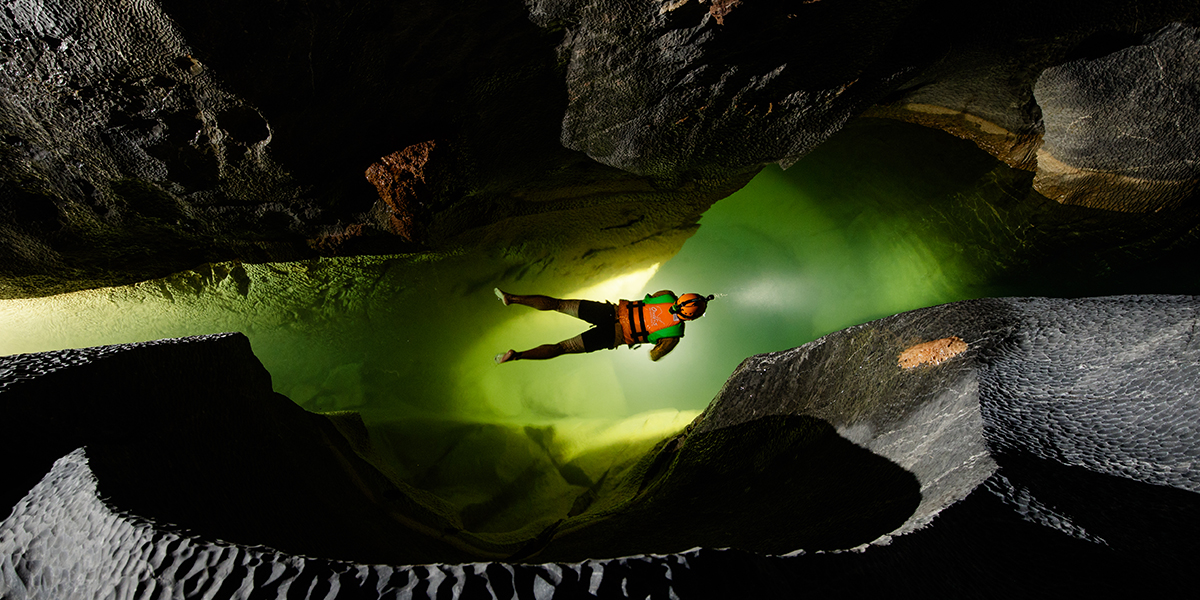
This is a 600-meter cave diving expedition in the underground river inside Son Doong Cave, which never been done or researched before, which means that the obstacles in the expedition are difficult to identify. There is no accurate information or the confirmation of the connection between Son Doong Cave and Hang Thung Cave until the diving expedition is completed with the final result. However, with all of the experiences the cave diving team had before; together with the professional porter team to help carry specialized equipment into the cave; the possibility of proving the connection between these caves, with positive results, is quite high. There will surely be many interesting things under the water.
4. IDEAS OF THE CAVE DIVING EXPEDITION
The idea for this cave diving expedition started when Mr. Chau A Nguyen (General Director of Oxalis Adventure) together with Mr. Howard Limbert (Technical Director of Oxalis, member of British Cave Research Association) was in Thailand offering support in the rescue of the Wild Boar football team trapped inside a cave in Chiang Rai, Thailand in 2018.
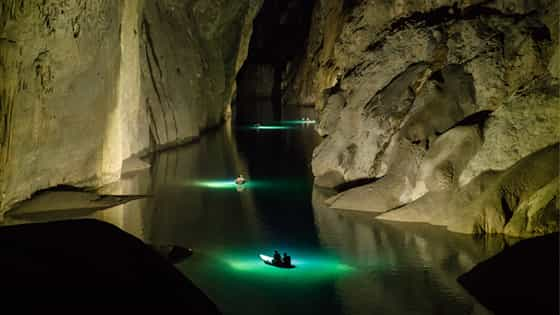
Mr. Howard then together with Mr. Chau A Nguyen & Mr. Martin Holroyd (another cave expert of British Vietnam Caving Expedition Team) planned to invite the divers from the rescue to join in an expedition to dive the underground river inside the Son Doong Cave; which is believed to be an interesting challenge for the divers, since this kind of exploration has never been done before and they would love to explore new caves as well.
5. PURPOSE OF THIS CAVE DIVING EXPEDITION
The purpose of this diving expedition in the underground river inside the Son Doong Cave is to find out whether there is the connection between Son Doong Cave and Hang Thung Cave, a huge cave discovered 1994, located 600m away from Son Doong Cave.
If the expedition could prove the physical connection between these two caves, this would make Son Doong Cave even larger and would enable Son Doong to the be largest natural cave in the world by volume and not only by size.
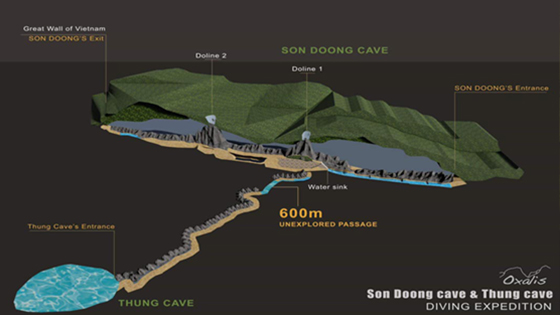
This expedition also opens up a new exploration opportunity for professional explorers to explore the mysteries that lie deep within the underground rivers of the cave system that have not really been researched for a long time.
It is possible that the mysteries within the underground rivers can contribute to scientific discoveries as well as geological and geomorphological information within cave systems.
6. ORGANIZATIONS & EXPLORATION TEAM
The expedition team comprises of the best cave diving experts in the world; along with the logistics team from Oxalis Adventure; to focus on the expedition from the 1st to the 6th of April, 2019. The exploration time duration is flexible and could be extended depending on cave & weather conditions.
- Planning Unit: Phong Nha – Ke Bang National Park Management Board
- Sponsor and Coordinator Unit: Oxalis Limited Company (Oxalis Adventure)
- Exploration Unit: Exploring team from British Cave Research Association in Vietnam
- Team leader: Mr. Howard Limbert – British Vietnam Caving Expedition team leader in Vietnam, Technical Director of Oxalis Adventure
- Diving team leader: Mr. Martin Holroyd – British Vietnam Caving Expedition specialist, Training specialist of Oxalis Adventure
- Diving members: Mr. Rick Stanton, Mr. Jason Mallinson and Mr. Chris Jewell. Mr. John Volanthen could not arrange to join the group this time.
- Diving equipment coordinator: Ms. Laura Jewell
- Oxalis Adventure Logistics support group: 25 people
- Documentary filming: Mr. Ryan Deboodt
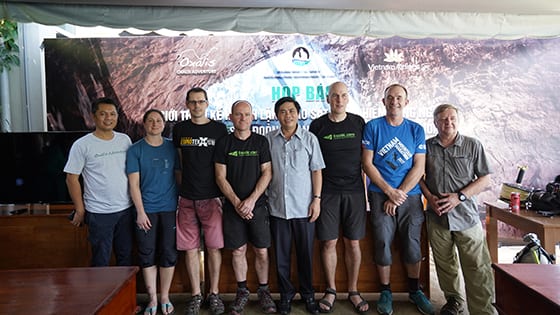
7. DIVING EQUIPMENT AND RESCUE PLANS
- Diving equipment
This diving expedition inside Son Doong Cave will use professional caving equipment and specialized diving equipment, coordinated and used by diving experts, called the ‘rebreather’. Rebreather equipment will make it possible for divers to stay longer under the water for explorations.
- Rescue plans
This is a professional team of diving experts with detailed plans to ensure safety during diving. There will only be one diver to dive at a time, the diver will carry a 200-meter-long dedicated rope and finish diving with it for 200m and go back. The next diver will dive to the 200m section of the previous diver, tie the rope and continue to follow each other like that until the way out is found. The diving experts will also carry a dedicated diving tank called rebreather, and two conventional diving bottles are reserved for use in case of a rebreather problem.
In case of unexpected weather conditions with heavy rain, the diving team will divide the team to wait for the divers at the other end of Hang Thung cave.
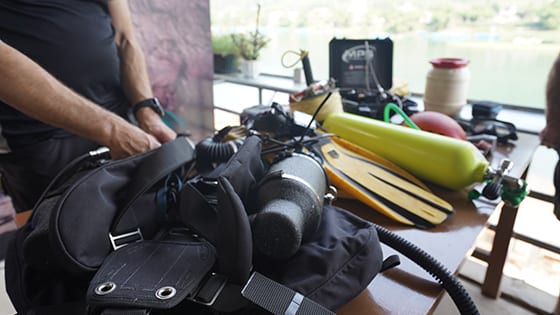
8. TIME OF DIVING EXPEDITION
From the 1st April, 2019 to the 6th April, 2019.
Note: The exploration time duration is flexible and could be extended depending on cave & weather conditions.
